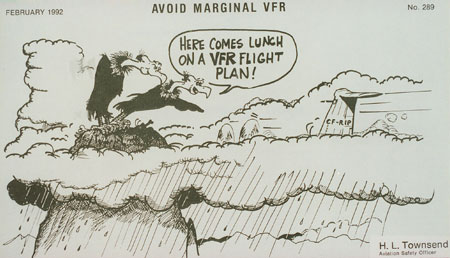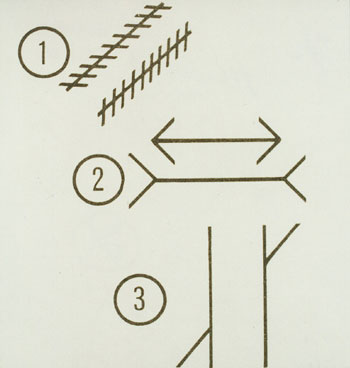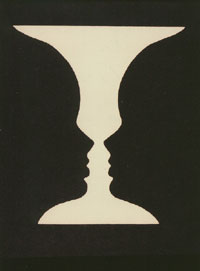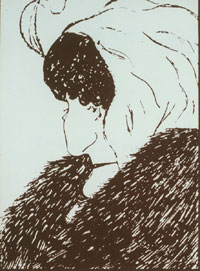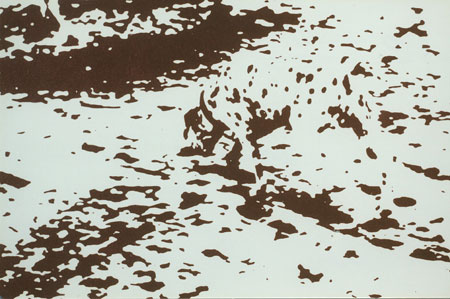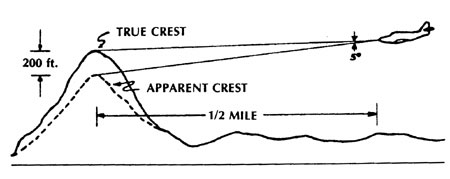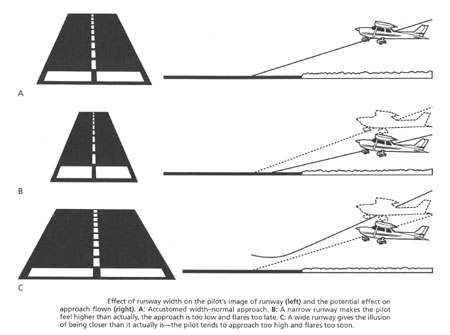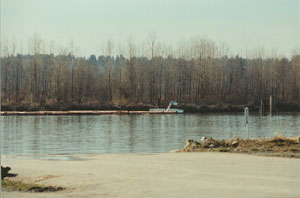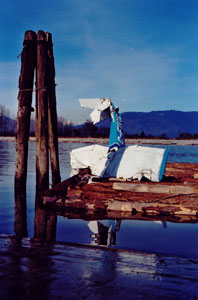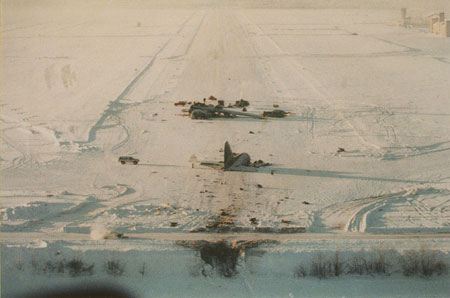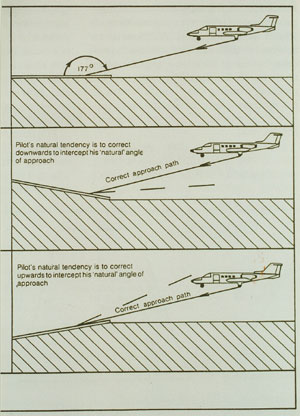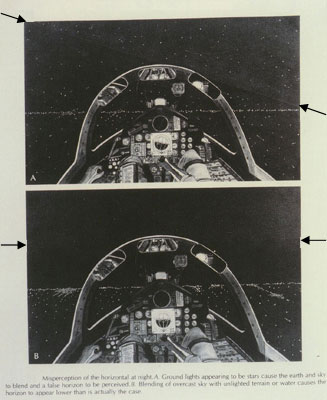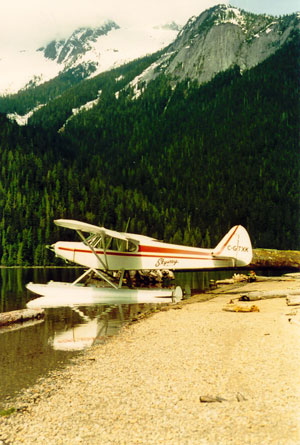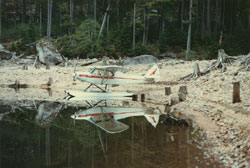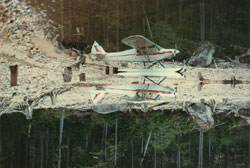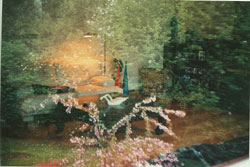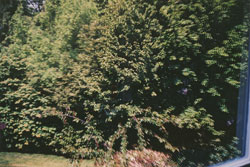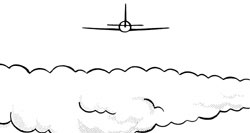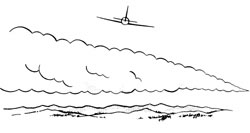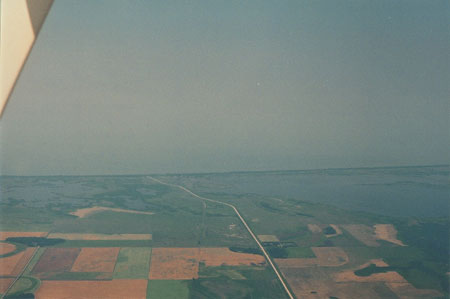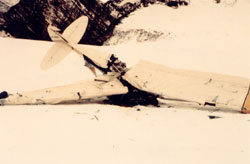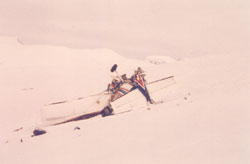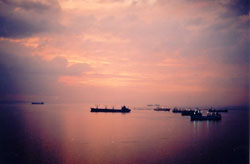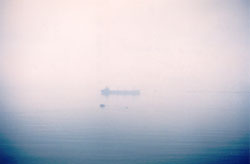Unrecognized spatial disorientation (Type I) describes a situation wherein the pilot is disoriented but is unaware and controls his/her aircraft using false sensory information. This may occur in visual or instrument conditions. There is little room for humour in dealing with this topic but the attached cartoon gives some insight into the mindset of disbelief when one is confronted with the stark reality of nature’s deceptive ways. The vultures anticipate lunch while the flight crew motors on unaware. They will not walk away from their controlled flight into terrain (CFIT).(Illustrations 2 )
As an Aviation Medical Examiner, I am very much aware of the importance of vision in pilot fitness. The medical examination includes distant, near, colour and peripheral vision testing as well as eye movements. The results tell me if a pilot can assimilate information from his/her environment and charts to navigate and avoid other aircraft on a collision course. It does not tell me his/her ability to correctly interpret what is seen. Perfect vision is not infallible. Visual illusions are the most common factor contributing to Type I accidents. The pilot misinterprets what his/her eyes see often with deadly consequences.
Many of us have experienced visual illusions while driving our automobiles. Driving in a mountain pass I have been puzzled by the unexplained deceleration as I am descending. The reality is I am climbing a grade. At an intersection I have jammed on the brakes as my vehicle starts to roll backward. The reality is the adjacent car is edging forward. My interpretation and reaction are in error. In a car wash the sensation is one of a stationary vehicle and moving brushes when the reverse is true. I always experience a sense of uneasiness as reality is declared and my mind and body reorient.
If you have not experienced the above and believe you are infallible, here are several textbook examples to play with: the first diagram (Illustration 3) has three figures that demonstrate how easy it is to deceive our eyes. The first two lines are parallel (1), the second two are equal in length (2), and the last two are in alignment with each other.
The next figure (Illustration 4) is a vase or two opposing facial silhouettes. Then there is the etching of the lady, young or elderly (Illustration 5) - both are looking to the left. The nose of the old lady is the cheek of the younger.
The next example is a bit more challenging (Illustration 6). There is a Dalmatian dog facing left and sniffing the ground, or is it a snowfield with rocks exposed? This brings to mind an experience I encountered while driving in Cypress Bowl with my family on a Sunday afternoon. Rounding a corner we were mesmerized by a half dozen skydivers silhouetted by snow and clouds. I pulled to the side of the road to observe their descent. The moment the car stopped, reality hit home. The parachutists were bare rocks in a snowfield. We had been deceived by a complex visual illusion of snow and rock with the motion of cloud and vehicle. In an aircraft there would have been time to bank and avoid a skydiver and fly headlong into an invisible snowbank!
Visual illusions encountered in flight deserve special consideration to increase awareness and avoidance of Type I disorientation. There are many variations of these themes and some quite likely unreported as the pilots involved did not survive to share their experience. Their last voiced words would have been “That’s bizarre!” or “What the ....” Here are some well described variations.
Heavy rain causes light refraction (Illustration 7). This can lead to approaching obstacles appearing lower than they actually are. The potential risk is a C.F.I.T. accident or undershooting the approach in a heavy rain shower.
Relative motion of the aircraft over the earth’s surface can be misleading when strong winds are encountered while maneuvering at low altitude. All pilots should have had this demonstration as students with Exercise 20 - Illusions Created by Drift and Low Flying. The danger is twofold -first with a strong tailwind comes an inherent tendency to throttle back to compensate for the increased ground speed. The illusion comes with the pilot’s brain equating ground speed and air speed. Low air speed and altitude leave little room above the stall for gusts and distraction. The second set up comes with course reversal from into to downwind. In the coordinated turn there is the illusion of a slip. The tendency is to skid with uncoordinated rudder. A tried and true “method” for inducing an incipient or full spin - not a healthy low level maneuver!
Runway size, slope and approach environment can add some interesting twists. A shorter narrower runway than the pilot is accustomed to can result in a higher than standard approach illusion resulting in an undershoot (Illustration 8b)The converse situation, with a longer wider runway (Illustration 8c) gives a lower than standard approach illusion leading to an overshoot or high flare in the landing configuration. During daylight the pilot has other visual cues to alert him/her to overcome the dangers of these illusions. Night flying has its perks but the risk of disorientation with these illusions is much greater.
My introduction to visual illusions came on my first dual night cross-country trip from Pitt Meadows (runway dimensions 75’ x 2500’) to Victoria (runway dimensions 200’ x 9000’). A flawless flight came off the tracks with a touch and go approach to runway 27 at Victoria. Throttled back I gradually raised the nose of Fleet Canuck CF-HHE to a perfect three point landing - in my mind’s eye. In the right seat hovered Jim Hora, my cheerful and resourceful instructor. I was puzzled by his increasing agitation. Unable to restrain himself any further, he leaned over and shouted in my ear:
“Jack, are you trying to kill us? We are 50 feet in the air!”
So we were and on the verge of a power off stall to boot. With judicious power and lowering the nose, the landing, HHE’s bungee cords and my crumbling ego were salvaged. Lesson learned, stored and remembered.
The sensation of landing on a lit runway at night has been compared to landing in a black box. This is especially true when there are no approach lights or vertical approach slope indicator lights (VASI) to guide the unwary pilot to the threshold. These conditions existed one night when a pilot approached over the Fraser River to land on runway 36 at Pitt Meadows. The accompanying photos (Illustrations 9 & 10) indicate that the flight terminated in an abrupt undershoot. The distant photograph (Illustration 9) shows a slash in the tree line just left of centre. Collision with treetops resulted in abrupt loss of control and impact with a stationary log boom. The pilot survived without serious injury to be rescued by a passing tugboat several hours later. One of the 10% or less to walk away or be carried alive from the scene of a disorientation accident.
The crews of two Canadian Forces C-130 Hercules aircraft were less fortunate. The first came to grief on January 29, 1989 at Fort Wainwright, Alaska. During a stabilized night Ground Controlled Approach (GCA) in ice fog the crew encountered the black hole phenomena on short final and descended below the descent profile. Illustration 11 indicates that the aircraft was too low to initiate the landing flare as evidenced by the foreground impact print. The veteran flight crew survived and was incredulous that its senses had been deceived.
The second accident occurred on January 31, 1991 during a night visual approach into Alert, NWT. A combination of loss of situational awareness and black hole phenomena resulted in terrain contact within sight of the airfield. The tragedy of this accident and the heroic rescue are chronicled in Robert Mason Lee’s ‘Death and Deliverance’.
When flying at night the pilot should be aware that when flying towards lights they should always become brighter and clearer. Fading or flickering lights should raise the alarm of trouble ahead. This is an indication of deteriorating weather or obstacles such as hills, trees, or wires on the flight path between the touchdown point and the aircraft. This calls for an immediate full power climb and/or course reversal. Keep in mind that clouds at night may be invisible until you find yourself in sudden unexpected IMC!
Landing on a sloping runway can also lead to dangerous illusions. The pilot attempts to maintain the same approach angle as with a level runway surface. With the downsloping runway this leads to a steeper approach angle and increased airspeed leading to an overshoot or runway overrun (Illustration 12)
The upsloping runway leads to decreased airspeed and undershoot tendency. The latter scenario is double jeopardy at night if the runway lacks VASI. The first indication the pilot may have that something is amiss is that unsuspected jolt of initial contact with trees or turf. GOTCHA....
Stars and ground lights at night can lead to a myriad of illusions that can seduce the unwary pilot caught ignoring his/her flight instruments. The attached illustrations give two such examples (Illustration 13) The upper pilot’s mental image is one of straight and level flight - but he/she has substituted the real horizon with a lit street. A look over the shoulder at the attitude indicator reveals an insidious left spiral dive ( arrows mark the real horizon). Without recognition and prompt recovery, impact would occur shortly after passing the street. The lower pilot is wings level but in a descent as he/she is oriented with a lit shoreline and not the natural horizon. Past the shoreline his/her lifespan will be reduced to seconds unless a quick glance inside the cockpit reveals the crazy unwinding altimeter.
Float flying has always been one of my aviation passions (Illustration 14). The natural beauty and solitude are unparalleled. But it can be risky business as the scarcity of rental floatplanes and exorbitant insurance rates attest to. One of the reasons for this is the alluring tranquillity of glassy water conditions. Every float plane student receives special instruction on the landing techniques to minimize the risk of this treacherous set up. Despite this, the following accident description occurs with undue frequency: Sea plane approaches to land, fails to flare, digs float tips or nose, flips inverted and sinks to the float bottoms. Pilot and passengers often succumb to impact injuries, drowning or hypothermia attempting to reach shore sans life jacket.
How can this be possible? The answer is spatial disorientation due to visual illusion. If you have ever walked nose first into a spotless plate glass door or window, you have experienced the shock and unpredictability of glassy water. The two pictures of a Supercub on Clowholm Lake give some idea of the ambiguity of glassy water (Illustration 15a & 15b). Photo 15a is reality while photo 15b is the same picture inverted. Under these conditions the ability to judge height for the touchdown is virtually impossible.
One afternoon while daydreaming on our sundeck, comprehension hit me: why birds fly into windows and float pilots succumb to glassy water. Different lighting conditions produced totally different pictures (Illustrations 16 & 17). In one, the light penetration was complete, revealing the house interior or the equivalent lake bottom. The other had almost complete reflection of light, giving a near perfect mirror image of trees or sky. In each picture, the deadly interface is invisible - for the birds: the glass pane, for the pilot: the glassy water surface.
The words of wisdom of my flamboyant float instructor, Jean Marc Ranger, to tackle this hazard will always be with me - flare at a set altitude over the shoreline, power-assisted descent in the landing attitude, focus on the distant horizon for reference, and never never look down until the floats are solidly on the water surface.
Sloping cloud layers can be a source of disorientation for pilots VFR on top or in IMC between layers (Illustration 18a and 18b). The tendency is to align the wings “level” with the false horizon. The risk of losing control increases when cloud is entered in a banked attitude. Any attempt to stop descent by pitching the nose up will progress insidiously into a spiral dive.
Under certain conditions of diverse light refraction and terrain absorption, IFR conditions prevail even though ceiling and visibilities are well in the VFR domain. The result is an indiscernible horizon and/or lack of ground shadows or contrast. This condition may be described as whiteout, greyout or in one case I have encountered - blueout (Illustration 19).
Accidents are often of the C.F.I.T. variety and have involved highly experienced Air Transport crews. For example, the Air New Zealand DC 10 crash in Antarctica. In this condition, the pilot has difficulty judging distance for obstacle clearance or height to assess the landing flare. In Illustrations 20 and 21 some insight is gained in the difficulty of judging distance when flying into white out conditions.
The two views of Manila Harbour contrast safe VFR and risky greyout conditions. (Illustrations 22 and 23). In the first picture the horizon is obvious. In the second, the breakwater on the right will be the pilot’s last contact with reality. For the VFR pilot, survival comes with course reversal before passing the last visual reference and plunging into the gray void beyond. The alternate accident scenario for this condition is loss of control when course reversal is made in IMC. In the turn the VFR pilot is distracted from instrument indications of a descent while struggling to regain outside visual reference. Unexpectedly, the low wing contacts invisible terrain and the aircraft cartwheels. Survival comes with avoiding this hazardous gold fish bowl with early course reversal or an instrument monitored rate one turn to a reciprocal heading if it is unexpectedly encountered.
A relatively new visual illusion was described by a S.A.R. helicopter crew that was investigating the crash of a S.A.R. Twin Otter that had impacted a sheer mountain face while involved in a search for a lost aircraft. When simulating the flight path of the Twin Otter in identical weather conditions, the helicopter crew observed the illusion of an empty valley ahead. The sun was low behind them creating a mirror effect with the sheer face. Low airspeed and greater maneuverability saved them from a similar fate. This condition could be considered the wheel pilot’s glassy water equivalent. It is quite likely that many other undescribed visual phenomena exist but as yet have not been described as there were no survivors from the resulting accidents. Dead men tell no tales!
